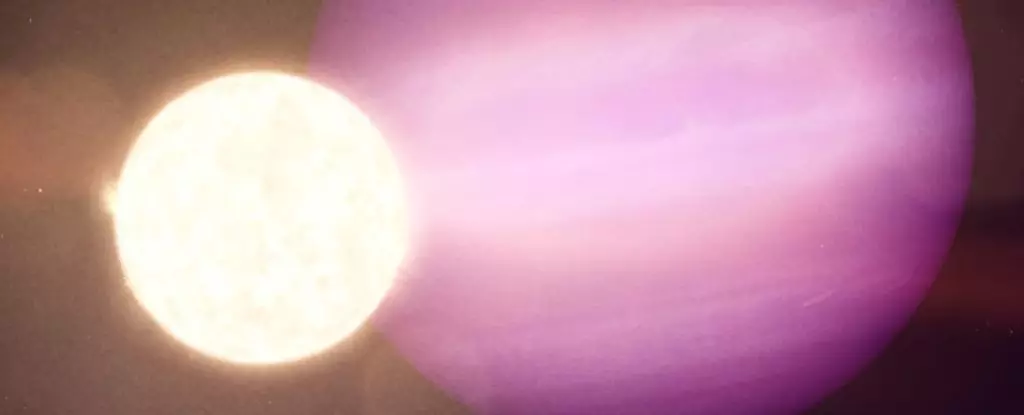In 2020, astronomers made a groundbreaking discovery with WD 1856+534 b, a gas giant orbiting a white dwarf star situated 81 light-years from our planet. What makes this exoplanet remarkable is not just its sheer size—approximately six times the mass of Jupiter and classified as a “super-Jupiter”—but its unique position orbiting a white dwarf. This discovery opened a new avenue for astrophysical research focused on the interaction between planets and the remnants of stellar evolution.
The international research team responsible for this observation, led by Mary Anne Limbach from the University of Michigan, utilized the cutting-edge capabilities of the James Webb Space Telescope (JWST) to carry out a detailed examination of WD 1856+534 b. With contributions from various esteemed institutions, including MIT and Johns Hopkins University, this collaborative effort highlights the importance of multi-institutional partnerships in advancing our understanding of cosmic phenomena.
The Coldest Exoplanet: A New Record
The recent research findings indicate that WD 1856+534 b holds the title of the coldest exoplanet ever detected, with an atmospheric temperature averaging around 186 K (-87 °C; -125 °F). This offers astronomers a unique window into the characteristics of exoplanets that reside in colder temperature ranges, directly challenging previous assumptions that revolve mainly around hotter, gas giant planets.
The JWST’s Mid-Infrared Instrument (MIRI) played a critical role in this discovery, employing a method known as the Infrared (IR) excess technique to analyze light reflected off the exoplanet’s surface. By detecting the faint emissions from the planet, the research team was able to refine their understanding of its mass and temperature—observations that had bloated earlier estimates of the planet’s mass to an astonishing 13.8 Jupiter masses.
Understanding Planetary Systems Around White Dwarfs
WD stars like the one around which WD 1856+534 b orbits are remnants of stars similar to our Sun, which have exhausted their nuclear fuel and collapsed into dense, hot cores. The presence of planets like WD 1856+534 b raises intriguing questions about the fate of planetary systems as their host stars exit their main-sequence life stages. Can these planets survive the cataclysmic events accompanying stellar death? How might they evolve in the aftermath, particularly in their migration patterns in relation to habitable zones?
Understanding these dynamics is crucial for astrophysicists, as it sheds light not only on planetary survivability but also on the evolutionary trajectory of entire solar systems. The research team’s analysis suggests that such proximity to a white dwarf does not automatically preclude a planet from maintaining stable orbits, nor does it negate the potential for habitats conducive to life.
Challenges and Opportunities for Future Research
Even though the JWST’s advanced technology has revolutionized how we observe distant objects, studying exoplanets remains fraught with challenges. The primary obstacle lies in detecting emissions from planets amid the glare of their much brighter stars. Historically, this has limited studies primarily to massive gas giants with wider orbits.
However, the unique conditions surrounding white dwarfs offer astronomers a unique advantage as their low luminosity allows for greater observation clarity. These favorable circumstances provide unprecedented opportunities to explore not just WD 1856+534 b, but potentially many other exoplanets that lie in similar post-main-sequence systems.
The researchers are eagerly anticipating follow-up observations scheduled for 2025, which may lead to the identification of additional planets in this intriguing system. There is excitement about the prospects of uncovering more about the orbital dynamics and atmospheric characteristics of WD 1856+534 b, potentially challenging current models of planetary formation and evolution.
The Broader Implications for Astrobiology
Beyond the realm of planetary science, the implications of studying WD 1856+534 b extend to astrobiology—questions of whether conditions suitable for life can arise in such extreme interstellar environments. The focus on biosignatures—chemical markers that might indicate life—is a paramount concern for future investigations, particularly in weakly illuminated systems like those surrounding white dwarfs.
The discovery and ongoing study of WD 1856+534 b represent a blend of scientific curiosity and technological achievement. As tools like the JWST continue to expand our observational capabilities, we find ourselves on the verge of breakthroughs that could redefine our comprehension of life beyond Earth. The cold gas giant isn’t just a distant world; it symbolizes the tantalizing mystery that the cosmos holds, beckoning us to explore further and discover what lies beyond the horizon of our understanding.


Leave a Reply